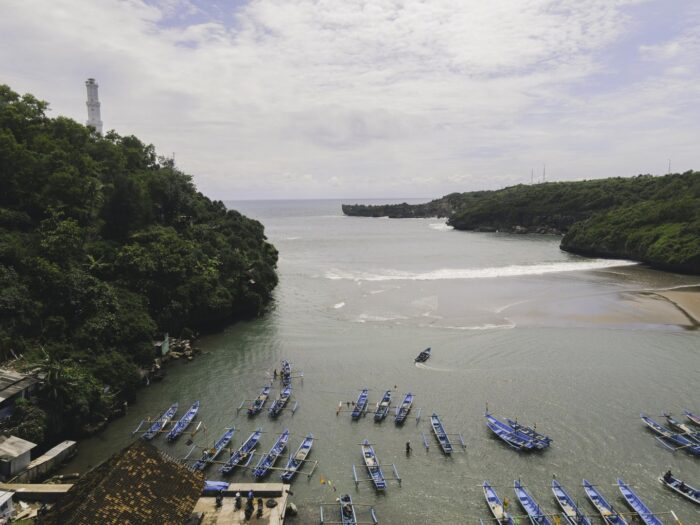Yogyakarta, known for its rich Javanese culture, also hides some incredible treasures in the form of stunning beaches. Stretching along the Indian Ocean, Yogyakarta boasts a long coastline with impressive waves.
These beaches lie to the south of Yogyakarta City, extending from Kulon Progo and Bantul all the way to Gunung Kidul (Wonosari). Each beach has its own unique charm: the western beaches, from Bantul to Kulon Progo, feature black sand due to volcanic activity and high iron content, while the southern and eastern beaches, stretching from Parangtritis to Gunung Kidul, are known for their white sand, karst hills, and small islands.
As you travel to these beaches, you’ll see green landscapes, forests, and natural beauty all around. There are many fun activities to enjoy, like walking along the shore, picnicking, camping, swimming, snorkeling, canoeing, or just watching the sunset.
I’ll guide you through the amazing beauty of Southern Yogyakarta. These are places I’ve personally visited, so I’ll share tips on how to get there, what to do, what to eat, and more. Let’s start our journey to discover Yogyakarta’s hidden treasures!
Natural Wonders of Yogyakarta’s Beaches

Bordering the Indian Ocean, the beaches in southern Yogyakarta showcase breathtaking natural beauty. You’ll find dramatic karst hills that have formed over thousands of years, alongside beaches with both white and black sand, shaped by volcanic activity.
The dry season, from April to October, is the ideal time to visit, with clear skies and sparkling waters that make it easier to spot marine life.
During the rainy season (November to March), the green karst hills will be a treat for your eyes. The scenery is just as beautiful as in the dry season, but rains more often come in the late afternoon, so you might miss out on seeing the sunset.
This area is also home to a mangrove forest that serves as a habitat for various bird species and other wildlife, as well as sea turtle conservation areas. Outdoor enthusiasts can hike the hills, climb the cliffs, or explore the surrounding caves.
With so many exciting activities, exploring Yogyakarta’s beaches is an absolute must during your visit to this beautiful region.
As a rich cultural heritage, Yogyakarta has many other destinations that you can visit.
Recommended Beaches in Yogyakarta
Parangtritis Beach

Parangtritis Beach, located in Bantul Regency about an hour from Yogyakarta City, is a favorite spot for locals and frequently hosts events. The beach is known for its black volcanic sand and stunning sunset views. There are plenty of fun activities here, like horseback riding, paragliding, and just relaxing by the shore.
You can get to the beach by taking the Abadi Bus from the Giwangan terminal in Yogyakarta or by renting a vehicle.
There are lots of accommodation options, from budget lodgings and hotels to villas and beach clubs with ocean views. You’ll also find many food stalls offering tasty seafood at an affordable price.
Parangkusumo Beach

Just 700 meters from Parangtritis Beach, Parangkusumo Beach offers a more spiritual atmosphere. As you approach, you’ll pass through a gate decorated with intricate cultural designs, and the air is filled with the scent of incense and flower offerings made to honor nature. This sense of mystery and sacredness is a major draw for tourists, especially during the Labuhan Ceremony on the 29th of Rajab (Islamic calendar) and the Melasti Ceremony, celebrated by thousands of Hindus before Nyepi Day. During these events, offerings of food, crops, and flowers are carried to the sea and released into the ocean. These ceremonies are highly anticipated by both locals and tourists to Yogyakarta.
Gumuk Pasir

West of Parangkusumo Beach lies Gumuk Pasir, a vast sand dune area that feels like stepping into the deserts of Africa or Arabia. It’s a favorite spot for photography, filming, sandboarding, and off-road adventures. You might even find a hidden beach nearby by following a rocky path southward for about five minutes.
Baron Beach

A bit farther out, you’ll find Baron Beach in Gunung Kidul (Wonosari). This beach serves as a gateway to other beaches in the region. Here, you can watch fishermen returning with their catch, take a boat ride along the coast, and witness a river that flows from underground into the sea. To get to the beach, you’ll need to take a boat, which costs about IDR 10,000 (around USD 0,64) per person. Swimming isn’t recommended due to a deep trench close to the shoreline.
Baron Beach is also known for its seafood, with plenty of places to try delicious local dishes. The beach is easily accessible via public transport, with the DAMRI shuttle running from Yogyakarta City. You can also visit the nearby lighthouse, and if you’re staying overnight, the Baron Lighthouse Cottage offers rooms with stunning sea views.
Krakal Beach

Krakal Beach, located east of Baron Beach, is known for its stunning natural beauty. You’ll find long stretches of white sand and coral hills that are perfect for climbing. From the higher spots, you can take in amazing sea views and even see nearby beaches like Indrayanti and Sadranan. Along the shore, you can spot small fish and hermit crabs among the rocks. In the morning, the cool breeze adds to the refreshing experience.
Canoeing and Snorkeling at Sadranan Beach

For snorkeling, Sadranan Beach is a great choice. It’s not far from Krakal Beach and has calm waters with a beautiful coral reef. You can snorkel to see small fish and other sea creatures. There are plenty of food stalls and places to rent canoes.
Backindo Tips: Wear protective footwear to avoid cuts from the coral reefs, and visit during high tide, which is usually in the morning.
Indrayanti Beach

If you’re looking for a beach with wide stretches of white sand, Indrayanti Beach is a must-visit. The beach is known for its beautiful white sand, surrounded by stunning karst hills. There are plenty of food vendors and seafood restaurants to try. Personally, I always go for the fried shrimp from the roadside stalls. The shrimp are big, fresh,sweet and juicy, it’s one of my favorites. This beach is very popular, so it can get crowded, but it’s still a gorgeous and romantic spot to watch the sunset.
Snorkeling at Nglambor Beach

For a more adventurous underwater experience, Nglambor Beach is a great choice. It’s a bit farther away from the popular white sand beaches like Indrayanti and feels like a hidden gem, visited by only a few. To get there, you’ll need to trek through a steep hill and then walk down to the beach. The effort is well worth it once you start snorkeling in the crystal-clear waters, watching small fish swim and anemones gently sway with the current.
Wediombo Beach and the Secret Lagoon
Wediombo Beach is a true hidden gem. Located about 70 km from Yogyakarta’s city center, near the border of Central Java’s Wonogiri, it offers exotic views with volcanic rocks from ancient eruptions, a mix of white and volcanic sands, and has a natural lagoon. Although it’s remote and uncrowded, the beauty makes the trip worthwhile.
The beach is perfect for surfing, with steady big waves, you can rent surfboards and take lessons for beginners. Wediombo is also a nesting site for turtles and is part of a turtle conservation area.
One of my favorite things to do here is swim in the lagoon, surrounded by volcanic rock walls. When the waves crash against the rocks, they create a spectacular splash, filling the lagoon with water. It’s an amazing experience!
Other Activities
In addition to visiting beaches in Bantul and Gunung Kidul, you can explore some non-beach nature spots. Check out the Pine Forest in Imogiri and Mangunan Fruit Garden in Bantul, both offering scenic viewpoints. In Gunung Kidul, you can hike ‘Gunung Api Purba’, an ancient volcano, which was formed by underwater volcanic activity 60-70 million years ago, or try cave tubing in Goa Pindul.
There are also plenty of other beaches to visit, like Goa Cemara, Pok Tunggal, Glagah, Drini (with its coral island), and Timang (with its gondola). Pick whichever activity suits you!
For Your Information: some beaches in Yogyakarta have entrance fees, usually starting from IDR 10,000 (around USD 0,64) and parking fees from IDR 5,000 (around USD 0,32).
How to Get to Yogyakarta’s Beaches

Since these beaches are far from the city, you have two options: public transport or renting a vehicle. Some beaches, like Parangtritis and Baron, are accessible by public transport. DAMRI shuttles are available from KM 0 in Yogyakarta City, going directly to Baron Beach terminal. There’s also a bus to Parangtritis from Giwangan terminal.
Alternatively, you can rent a vehicle. Many rental services offer motorcycles and cars with drivers who know the routes to the beaches. You can book rentals online through platforms like Klook and Booking.com, or ask your hotel staff for assistance.
If you’re considering using Grab or GoJek, I’m not sure they’d cover long-distance pickups and drop-offs, although they might still agree to go to Parangtritis.
To help you get around Yogyakarta easily, we've gathered all the key information about public transportation in the city.
Best Time to Visit

The best time to visit Yogyakarta’s beaches is during the dry season, from April to October. You can also visit during the rainy season (November to March), but it’s best to go in the morning, as it usually rains in the afternoon. Rain isn’t too frequent, with the heaviest rains typically from January to early March. One benefit of visiting in the rainy season is that the mountains around Gunung Kidul become lush and green.
Since the beaches are quite far from the city center, it’s a good idea to start your trip in the morning. You can visit several beaches in a day and stay until evening. If you plan to stay overnight, there are villas, beach clubs, and homestays available. Some beaches even allow camping—I once camped at Sadranan Beach and enjoyed snorkeling in the refreshing morning waters!
Try to avoid weekends and school holidays, as the beaches can get very crowded. On your way back to Yogyakarta, you might hit heavy traffic. My tip for visiting during these times is to leave early, around 5 or 6 AM, so you can enjoy a relaxed breakfast by the beach.
As a tropical country, Indonesia has two seasons, the dry season and the rainy season. For more details, we present them in Best Time to Visit Indonesia.
Yogyakarta is a fantastic destination for a variety of activities, offering both rich cultural and historical experiences, as well as stunning natural beauty.
